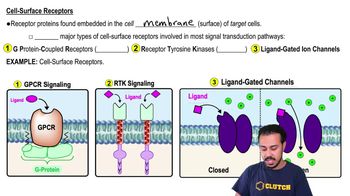Binding of a signaling molecule to which type of receptor leads directly to a change in the distribution of substances on opposite sides of the membrane? a. intracellular receptor b. G protein-coupled receptor c. phosphorylated receptor tyrosine kinase dimer d. ligand-gated ion channel
The activation of receptor tyrosine kinases is characterized by a. dimerization and phosphorylation. b. dimerization and IP3 binding. c. a phosphorylation cascade. d. GTP hydrolysis.
 Verified step by step guidance
Verified step by step guidance
Verified video answer for a similar problem:
Key Concepts
Receptor Tyrosine Kinases (RTKs)

Dimerization
Phosphorylation

Lipid-soluble signaling molecules, such as aldosterone, cross the membranes of all cells but affect only target cells because a. only target cells retain the appropriate DNA segments. b. intracellular receptors are present only in target cells. c. only target cells have enzymes that break down aldosterone. d. only in target cells is aldosterone able to initiate the phosphorylation cascade that turns genes on.
Consider this pathway: epinephrine → G protein-coupled receptor → G protein → adenylyl cyclase → cAMP. Identify the second messenger. a. cAMP b. G protein c. GTP d. adenylyl cyclase
Apoptosis involves all but which of the following? a. fragmentation of the DNA b. cell-signaling pathways c. lysis of the cell d. digestion of cellular contents by scavenger cells
